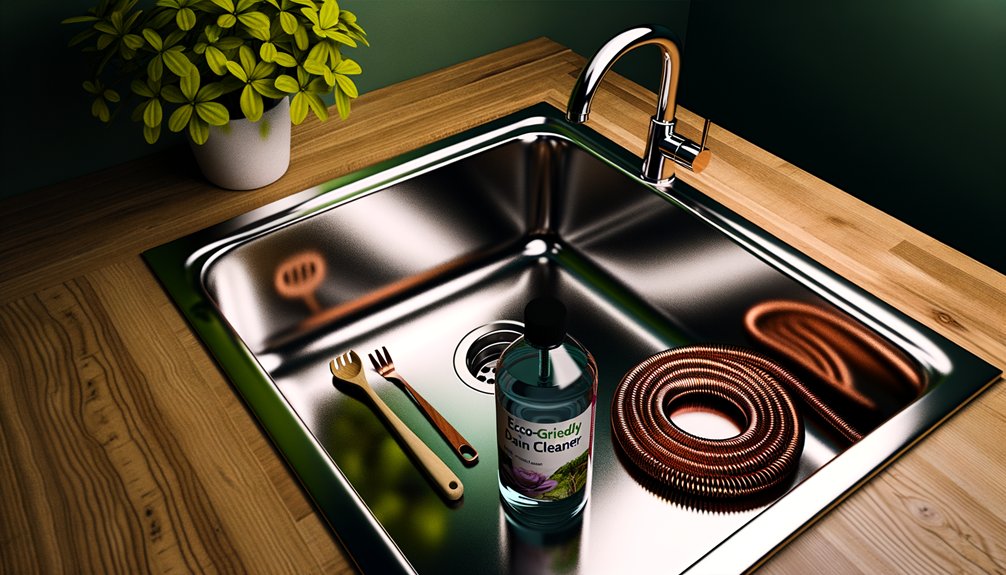Slow-draining sinks can often be remedied through simple solutions. First, clean the pop-up stopper to remove hair and debris. Employ a zip-it tool for capturing soap scum and hair. Boiling water can dissolve minor clogs, while a DIY drain cleaner made of baking soda and vinegar is effective. If issues persist, consider using a plunger or reevaluating for potential blockages. Awareness of warning signs can guide further actions for improved drainage. More effective techniques await further exploration.
Identify the Cause of Slow Drainage

When addressing slow-draining sinks, it is vital to identify the underlying cause before attempting any solutions. Common culprits of a slow draining sink include clogs formed by hair, soap scum, food particles, and grease. These materials accumulate over time, obstructing proper water flow. Additionally, one should inspect for foreign objects that may have inadvertently fallen into the drain, as these can considerably hinder drainage. In areas with hard water, mineral build-up can further exacerbate the issue by narrowing pipe passages. Utilizing a flashlight to examine the interior of the drain can reveal visible blockages or mystery gunk contributing to the slowdown. If multiple drains exhibit similar slow drainage issues, it may indicate a more serious plumbing problem involving the main sewer line, necessitating professional drain cleaning to restore ideal function. Understanding these factors is vital for effective remediation.
Quick Fixes for Common Clogs
Numerous quick fixes can address common clogs in slow-draining sinks effectively. These methods target the buildup of hair, soap scum, and other debris that obstruct proper flow. Homeowners can utilize the following techniques:
Quick fixes, like cleaning stoppers and using boiling water, can effectively tackle common sink clogs and restore proper drainage.
- Remove and clean the sink's pop-up stopper to eliminate hair and debris.
- Employ a zip-it tool to capture and remove hair and soap scum from the drain.
- Pour boiling water down the drain to dissolve minor clogs, ensuring it is safe for plastic pipes.
- Create a DIY drain cleaner by mixing ½ cup of baking soda and ½ cup of vinegar, allowing it to fizz before rinsing with boiling water.
In more stubborn cases, a plunger can create suction to dislodge clogs effectively, especially when water is present in the sink. Each of these methods contributes to the essential process of cleaning the drain and restoring functionality.
When to Seek Professional Help

Although many slow-draining sink issues can be resolved with DIY methods, certain situations warrant professional intervention to prevent further complications. Homeowners should be vigilant for signs indicating a need for plumbing repair.
| Warning Signs | Possible Causes | Recommended Action |
|---|---|---|
| Multiple slow drains | Main sewer line blockage | Call a licensed plumber |
| Persistent slow drainage | Serious plumbing issue | Consult a professional |
| Gurgling sounds | Air trapped in pipes | Seek expert evaluation |
| Water backing up | Significant blockage | Immediate intervention |
If a bathroom sink exhibits these symptoms, particularly water backing up into other fixtures or tree root intrusion in older homes, it is essential to contact a plumber. Attempting to clear stubborn clogs without expertise may exacerbate the problem, underscoring the importance of recognizing when to seek professional help.
Frequently Asked Questions
How to Fix a Sink That Drains Slowly?
To address a slow-draining sink, one should prioritize drain cleaning and pipe inspection. Start by removing any visible debris and employing DIY solutions like a drain zip tool to eliminate hair and soap scum. For effective clog prevention, utilize a baking soda and vinegar mixture followed by boiling water. Regular sink maintenance, including cleaning the P-trap, is essential for optimizing water flow in kitchen drains and bathroom sinks, ensuring longevity of plumbing basics.
What Will Dissolve Hair in the Drain?
To effectively dissolve hair in drains, various methods can be employed. Hair dissolving agents, such as enzyme drain cleaners, target organic matter, while natural drain remedies like the baking soda and vinegar method create a chemical reaction that helps disintegrate hair. The boiling water method can also assist in melting grease. For maintenance, using a drain snake tool regularly prevents clogs, alongside adopting hair clog prevention strategies like installing drain covers.
What Do Plumbers Recommend for Slow Drains?
Plumbers recommend various plumbing tips for managing slow drains, emphasizing regular drain maintenance to prevent common clogs. Effective DIY solutions include using a combination of baking soda and vinegar or boiling water to enhance water flow. Plumbing tools like drain zip tools facilitate the removal of debris. For thorough sink care, professional advice often includes drain inspection and cleaning the P-trap. If issues persist, consulting a plumber may be necessary to address underlying problems.
What Is the Best Homemade Drain Cleaner?
Like a volcano bubbling with potential, a vinegar solution combined with baking soda offers an effective homemade drain cleaner. By following this with boiling water, one can enhance its efficacy. For additional power, a salt mix or enzyme cleaner may be utilized, while citrus peels and dish soap can help maintain drain hygiene. This natural approach, free from harsh chemical cleaners, promotes ongoing drain maintenance and guarantees a smoother flow.



